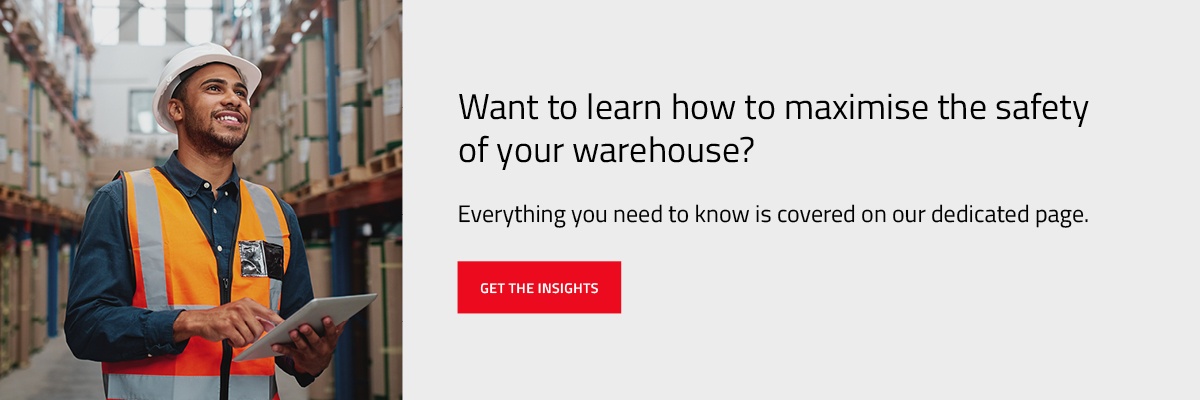Creating a safe environment in your warehouse is essential for keeping employees motivated, maximising output and keeping costs low. It also ensures you remain compliant and maintain a positive brand image. But do you know the warehouse health and safety regulations in the UK? And are you meeting them all?
.jpeg?width=952&name=AdobeStock_357275993-1%20(1).jpeg)
This article will look at the different warehouse health and safety regulations, explaining what they mean for your business.
The Health and Safety Act 1974.
The Health and Safety Act 1974 is the primary legislation covering occupational health and safety in Great Britain.
As part of the legislation, business owners must take on various tasks to ensure employee safety. These include:
- Carrying out a warehouse risk assessment and putting measures in place to remove or reduce any risks you identify.
- Providing your employees with information about risks and offering any necessary training. For example, if you have forklifts in your warehouse, you should regularly run forklift operator training.
- Regularly consulting with your staff on health and safety issues and sharing your insights with employees.
You can read the legislation in full to ensure you remain compliant here.
The Provision and Use of Work Equipment Regulations 1998 (PUWER).
PUWER aims to ensure the safety of people and businesses operating, maintaining and controlling equipment and machinery in their workplaces.
Under PUWER, all high-risk work equipment requires a Thorough Examination by a competently trained person.
Lower-risk and simple work equipment items can be visually inspected in-house by experienced staff, providing they have received the required training and are competent. This Thorough Examination is also known as LOLER — another critical warehouse health and safety regulation you need to know about.
The Lifting Operations and Lifting Equipment Regulations 1998 (LOLER)
LOLER aims to ensure that lifting equipment, including forklifts, cranes and tow tractors, are suitable for the workplace.
The legislation states that a competent person must carry out all lifting operations and use of lifting equipment. This person must be someone with the correct skills, knowledge, training and experience.
It is also required that all equipment used for lifting is fit for purpose, appropriate for the task and suitably marked. This is done through a periodic Thorough Examination.
Watch the video below to learn more about what a Through Examination is and how they work.
The Manual Handling Operations Regulations 1992.
In the UK, one in three accidents at work is caused by manual handling. Therefore, it is essential to ensure all manual activities are approached correctly. This is where the Manual Handling Operations Regulations 1992 can help.
As an employer, you are responsible for taking on various tasks as part of this regulation. These include:
- Ensuring hazardous manual handling is avoided in the workplace. This is where solutions such as forklift trucks can have a significant impact.
- Regularly assessing the risk of unavoidable manual handling and following best practices where necessary.
- Putting measures in place to minimise risk when completing these activities.
The Work at Height Regulations 2005
Working at height continues to be one of the biggest causes of fatalities or major injuries in the workplace. According to guidance, an employee is working from height if they:
- Work above ground or floor level.
- Could fall from an edge, through an opening or fragile surface.
- Could fall from ground level into an opening in a floor or a hole in the ground.
If your employees work from above ground or are vulnerable to the risks mentioned above, ensure you know about the Work at Height Regulations 2005.
As an employer, you are responsible for ensuring this type of work is appropriately planned, supervised and carried out by competent people.
You can read about the legislation in detail here.
The Control of Substances Hazardous to Health Regulations 2002 (COSHH).
COSHH aims to determine how hazardous substances are handled and stored in the workplace.
Types of hazardous waste that might be present in your workplace include chemicals, fumes and gases.
As a business owner, you have specific responsibilities related to COSHH. These include:
- Carrying out a COSHH assessment to identify the risks imposed by substances.
- Preventing your employees' exposure to hazardous substances at all times.
- Implementing measures to control the risks associated with hazardous waste in the workplace.
Understanding these different health and safety regulations is critical for reducing injuries and minimising the number of lost working days.
It can also lower employee turnover and reduce the threat of any legal issues. However, we understand that keeping up with regulations is no easy ask. This is why you should consider offering health and safety training to your employees. Not only is safety vital for optimising the safety and efficiency of your operation, it can also help you reduce costs and meet environmental goals. Discover the training we offer below.
.jpeg)

